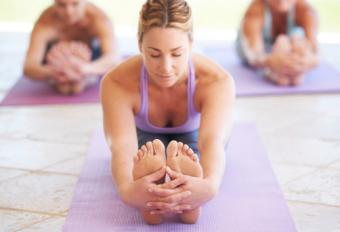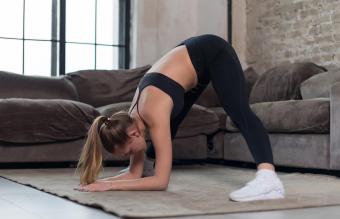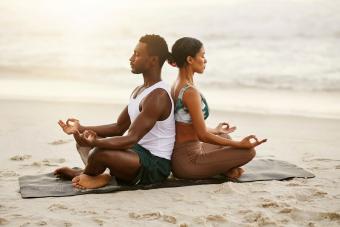
Feeling like your yoga practice is ramped up to be a little too yang these days? Yearning for greater flexibility and a more peaceful session on the mat? Yin yoga, performed at a near-glacial pace, may be your next great adventure. Yin is the softer, more yielding principle of yin-yang, and yin yoga is slower, more reflective, and more still than your power yoga or ashtanga class.
The Tao of Yoga
Yin yoga is based on the Tao, the universal principle underlying all things, and it is designed to dig deep into the practitioner's body and awareness. Most of the postures are performed seated or lying down and include stretches, static poses, and breath work. Asanas are held for anywhere from three to five minutes up to 20 minutes. It's slow yoga and targets connective tissue, fascia, tendons, and ligaments more intensively and completely than faster-paced, more active yoga can do.
Mind Over Muscle

The point of yin yoga is to ease and protect stiff joints, especially the connective tissue of the lower spine, pelvis, and hips. This is an aid to proper meditation posture and counters the inflexibility that comes with aging or rigorous athletic training. At the same time, the practice is calming and restorative, stimulating the chakras and the nadis, or energy channels, to encourage balance and an unblocked energy flow throughout the body. A yin approach lowers stress and improves focus and stamina.
Simon Low, co-founder of Triyoga Studio in London and of The Yoga Academy teacher training program, points out that a traditional yoga class is linear; it moves through a series of active, dynamic asanas, warming up and cooling down. Yin yoga is more circular, like nature itself, as the yogi spirals deeper and deeper into each pose.
"Yin yoga is a combination of restorative asana and more challenging passive, earth-based postures," Low says in a LoveToKnow interview. "This meditative yin practice is deeply nourishing…we build reservoirs of energy. Working particularly deeply with our breath, we can journey into the innermost realms of our being, as we explore and understand the deeper meditative qualities of yoga practice."
Give and Get
Letting go of challenging hot yoga, competitive power yoga, or aerobic fitness goals for your mat work delivers a basket of benefits, whether you combine yin classes with more traditional yogas or go all-yin. Some of the benefits yin yoga provides are:
- Open hips
- Relaxed pelvic area
- Stronger, pain-free lower spine
- Better mobility in all joints
- Calm and centered mind
- Balanced body and free energy flow
- Lower stress
- Better anxiety management
- Improved lubrication and protection of joints
- More elastic fascia (the sheath of fibrous tissue enclosing a muscle or other organ)
- Increased stamina
- Effortlessly still meditation seat
- Improvement of your more yang yoga practice
Do It Differently

In most yoga classes, sequences are active combinations of stretches, seated and standing poses, inversions, twists, and bends. You perform dynamic and muscular moves that lengthen and contract muscles, build internal heat, and even raise your heart rate. This more vigorous or yang yoga also lowers stress, improves fitness, increases range of movement, and balances the body's energy flow. But it doesn't -- and isn't designed to -- go deep into muscles and connective tissue to release old blockages and new injury- or age-related stiffness. Yin yoga is like sitting zazen: you assume the posture, settle into it, and hold it in stillness and awareness for an extended length of time. This can get uncomfortable and takes some adjustment. Yin yoga isn't a gentle nap. However, it rewards perseverance on a different level than a traditional yoga practice.
Get Down, Stay Down
Asanas in yin yoga are similar to but not identical to hatha asanas. Their names don't always align with the names of the poses you may be familiar with, a trick to alert you that you are on an atypical journey with yin. The difference is that the yin versions are approached with the mindfulness you will find your best posture and hold that pose for minutes, not breaths. As your muscles and connective tissue relax, you may be able to deepen the pose after a few moments. If you are particularly stiff or injured, props are encouraged, and a good teacher will offer modifications to enable you to stay in the pose safely. You don't blaze through a long list of poses in yin class; you'd be there all day if you tried to do that. But you do wring every last bit of value out of the poses you attempt.
Swan
Swan pose is the yin version of hamsasana (swan in hatha yoga), but it more closely resembles traditional one-legged pigeon pose. In a yin sequence, you start in upright swan, one leg bent, one leg extended behind you, torso erect. After a few minutes, you gently move into sleeping swan with the torso long and the head resting on a bolster or the crossed arms. As the asana ends, a few light stretches prepare you for the opposite-side swan, or the next pose.
Dragon
A dragon sequence opens the hip flexors and proceeds through several variations. Yin dragon resembles classic warrior 1 and 2. But dragon is lower to the ground and progresses into a different partial twist called lizard, which becomes a more interesting whole-body twist, naturally called dragon twist. You may move through an entire sequence, spending a minute -- or five -- in each position. Or you might limit a session to just the first dragon, holding it for several minutes before releasing, shaking out in downward-facing dog, and switching to the other side.
Butterfly
A yin butterfly is baddha konasana, bound angle pose, with legs angled into a relaxed diamond rather than pulled strongly in towards the torso. It works all the leg and hip muscles and connective tissue without emphasis on just the groins or just the hamstrings. As you deepen the pose, you gradually move the arms forward, stretching the spine and lowering the head. Coming out of yin poses is also a slow process and involves counter stretching to shake out any tightness from holding the pose.
Yin on the Mat
Observing a yin class is a little more exciting than watching paint dry, but taking the class is all kinds of drama. It's not your mama's yoga class. You may not need a mat. You will need pillows, bolsters, a blanket; a studio will provide the props and comfy items. There is no warm-up sequence. You go right into the first yin pose with cold muscles. The reason for that is warmed-up muscles are actively engaged and will absorb most of the stretch. You want to go deeper than that, so you ease into each pose just to the point where it becomes stressful and that's where you hold. The teacher will offer demonstrations and a running dialog of guidance and encouragement, supply props, and suggest modifications. You won't cover a lot of ground -- a handful of poses -- but you will have traveled to a new level of practice by the time the bell sounds softly at the end of class.
Basic Prep
Skip the trendy lycra and wear loose comfortable clothes, with layers to conserve body heat. You won't be working up a sweat and you don't want to become chilled. No eating before class, but a shower wouldn't hurt. Most studios ask you to leave off the perfume as class involves deep breathing. Put your phone on airplane mode -- do this at home, too. Don't take class when you are exhausted or rushed.
Sample Sequence

A sample yin yoga session in Yoga Journal balances the kidney meridian, an energy path through the body. It's a slow flow through nine poses: butterfly, saddle, sphinx, seal, child's, half-dragonfly, dragonfly, full forward bend, and savasana. You spend three to five minutes in each pose -- you may have to work up to this -- relaxing and breathing mindfully with long breaths between poses. In meditation, you continually return your attention to the breath in order to still your chattering mind. In this yin sequence, you stay attentive to your body, minutely flexing and relaxing muscles in response to subtle signals of discomfort or ease.
Tough Truth About Soft Yoga
Yin yoga is not for wimps, and it isn't designed to rehabilitate an injury. Holding muscles at the point of resistance for long stretches can seem excruciating. Even after you settle into a practice, the discipline is rigorous, the relief upon releasing a pose is palpable. If you are injured, pregnant, or have a serious medical condition such as diabetes or high blood pressure, consult your doctor before starting yin yoga. Manage your expectations -- the experience is nothing like your vinyasa studio. Yin yoga is not competitive but you should approach it with all the resolve and concentration of a serious athlete. Then hit your meditation cushion to lock in all the advantages of slow yoga and your more relaxed and non-fidgety body.







